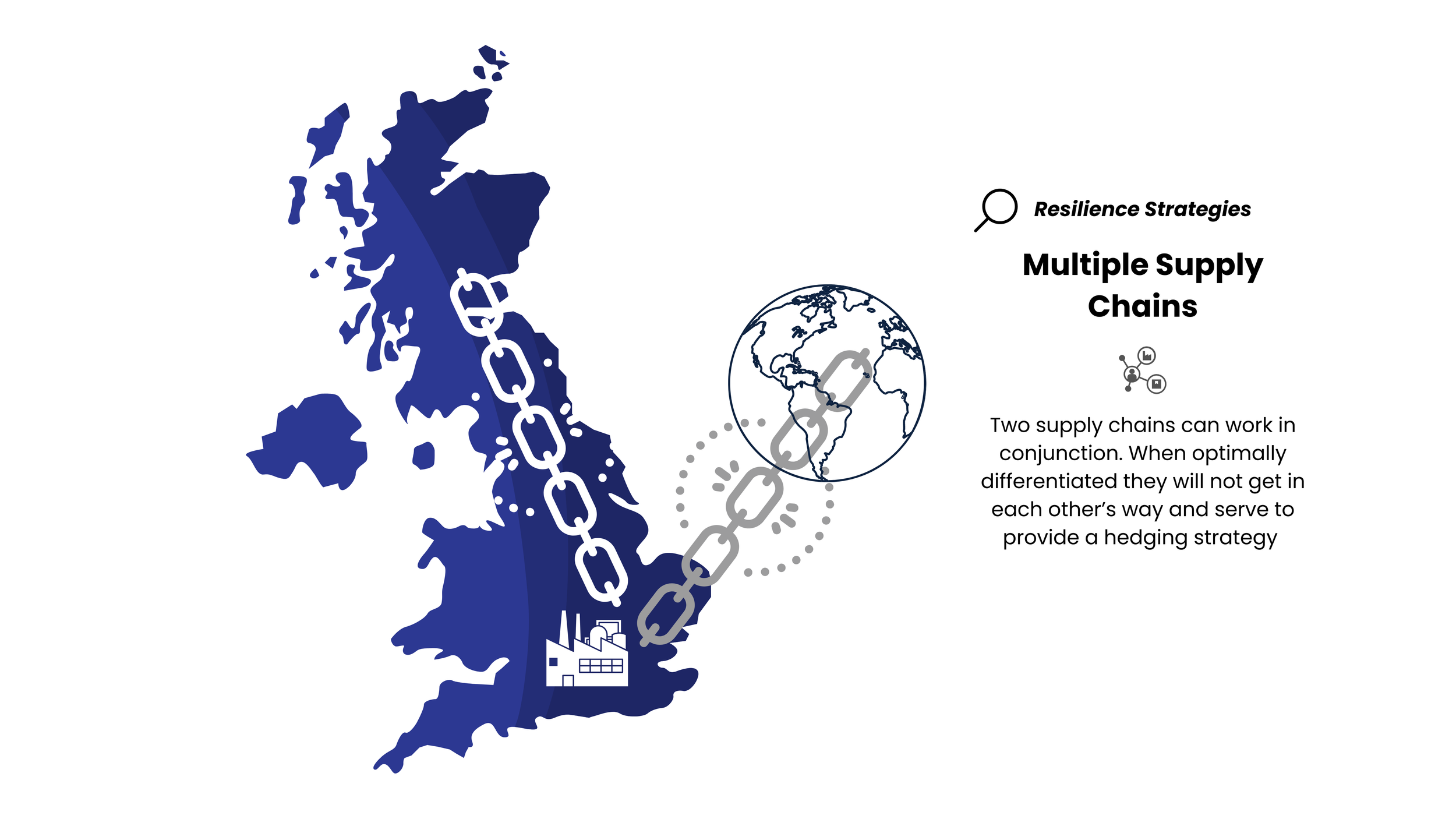The Great Reshoring: Avoid Getting Stranded
The pressing need for supply chain security and assurance has accelerated the topic up the academic, political, and commercial agendas of many nations. With clear demand and governmental support, reshoring is becoming increasingly prevalent in the UK, particularly within the manufacturing sector [1]. Defined as ‘the process of returning business to its country of origin’ [2], a key motivator for this move is risk mitigation. However, the UK’s score of 70.83/100 in the vulnerability index is below the European average [3]. Many companies have now begun to re-evaluate their decision to prioritise cost-efficiency over reliability, deciding to establish domestic supply chains. A recent study by Make UK found that over 75% of UK organisations have increased the number of domestic links in their supply chain, with over half agreeing this trend will continue [1]. The market-wide ramifications of this shift must be understood by leaders who wish to capitalise on opportunities and overcome the challenges of reshoring.
Reshoring is seen as a necessity by many in this country, given that the UK’s score of 70.83/100 in the vulnerability index comes in below the European average [3].
Reshoring is expected to bring many advantages to the UK economy and strengthen national competitiveness. For organisations, the key advantages to consider are as listed:
Reliability – With a UK-based supply chain, companies can be better insulated from global shocks that are becoming increasingly prevalent in a rapidly-changing world [4]
Control – Many companies realise the benefits of being close to the customers, this philosophy similarly applies to upstream management. Being close to your supply chain gives you greater access and collaboration [5]
Knowledge – Operating a regional supply chain can allow for the opportunity to increase visibility and transparency through closer relationships with suppliers. This can enable leaders to pre-empt or avoid risks, such as upstream ESG concerns that have impacted many companies [6]
The advantages brought by reshoring are exciting to consider, yet even more important to understand are the challenges that come with this shift. Among the most important of these are increasing costs, temporary disruptions, isolation and complexity.
Increasing costs – The key driver of globalisation was cost efficiency; many are concerned that these cost efficiencies will reverse as more companies restart production in the UK [7]
Temporary disruption – Not every organisation has the capital or ability to run multiple plants in synchronicity and the moving of production could be delayed due to the complexity of reshoring. This could cause further operational delays weakening (in the short-term) an already fragile supply chain [8]
Reduced access to global capital – Isolating operations to one country will always present the risk of missing opportunities to learn about or access global talent, innovations, and organisations [7]
Change management burden – As suppliers relocate, this will impact availability, transport methods, lead times etc. from this supply chain management and procurement processes will inevitably need to be re-assessed and re-organised. As an in-house process, this can be complex and costly in both time and resources [9]
Data demonstrates that organisational interest in reshoring is at its highest level since 2005 with companies looking to de-risk their supply chain favouring just-in-case over a just-in-time model [7]. To make this an effective transition, this article proposes three key solutions and best practices to be implemented in order to mitigate the consequences of supply chain reshoring:
Contingency planning – Operating a UK-focussed supply chain can provide protection and security against global or external shocks; however, this is not a silver bullet. Internal changes, shocks and crises will have a concentrated impact on the organisational supply chain. It is recommended that companies regularly complete comprehensive contingency planning sessions to evaluate risks to enable the organisation to act swiftly when disruptions arise [10, 11]
Supplier relationship management – This is a best practice initiative that should be implemented with the aim of achieving greater communication, access, and transparency. It is important to focus further upstream to gain a more granular understanding of the challenges suppliers face to identify risks and better plan for potential disruptions. In some cases, new technology such as AI or ERP software integration can support process automation or standardisation. Recently more specialised tools such as Tracelink have come to market providing the ability to manage the whole supply chain on a consolidated platform [12, 13]
Operating multi-faceted supply chains – The goal of reshoring is to boost supply chain security, but as explained operating a concentrated supply chain carries its own security risks. It should also be highlighted that although reshoring is growing, globalisation is not over and international markets can be explored to run as a parallel supply chain option to further extend security and ensure stability. Like having a stool with multiple legs if someone takes one leg away it may be harder, but you can still use the stool [14, 15]. Multiple or parallel supply chains also provide greater flexibility, prevent bottlenecks, and keep businesses agile as multiple suppliers collectively have more capacity and buyers are able to avoid consequences by shifting within their multiple chains as their business requires. As rivals across supply chains recognise new competition, cost and quality advantages could develop [16]
Solutions that meaningfully build resiliency are rarely easy to implement but are essential to successful supply chain management over the long term and for overcoming the challenges posed by UK reshoring. Deecon are experts in end-to-end supply chain and procurement optimisation, and we work collaboratively with our clients to create future-proof strategies that match their needs and accelerate results. If this is of interest to you or your company follow this link https://www.deeconconsulting.com/contact-us or email info@deeconconsulting.com
Words by Ashton Harsh
References
1. https://www.ft.com/content/8127dbfd-a464-4ee5-9581-ff1edb22e20c
2. https://www.investopedia.com/terms/r/reshoring.asp
3. https://www.investmentmonitor.ai/analysis/supply-chain-vulnerability-index-2022
4. https://geomiq.com/2021/03/03/reshoring-uk-manufacturing-post-brexit/
6. https://bhamspec.co.uk/its-coming-home-the-uk-manufacturing-shift-towards-reshoring/
7. https://www.ft.com/content/0599878e-a820-4657-8e52-f069bb10d512
8. https://www.mhlnews.com/global-supply-chain/article/21234768/the-benefits-pitfalls-of-reshoring
10. https://www.riskmethods.net/resilient-enterprise/why-every-business-should-have-contingency-plans
11. Building supply chain resilience in the era of COVID-19: An AHP-DEMATEL approach - https://link.springer.com/article/10.1007/s12063-021-00200-4
12. https://www.arenasolutions.com/resources/articles/should-you-move-manufacturing-closer-to-customers/
14. https://committees.parliament.uk/publications/2177/documents/20125/default/
15. https://www.bbpmedia.co.uk/business-insights/manufacturing/reshoring-manufacturing-to-the-uk.html
16. https://nibusinessinfo.co.uk/content/choose-between-single-or-multiple-supplier-strategy



